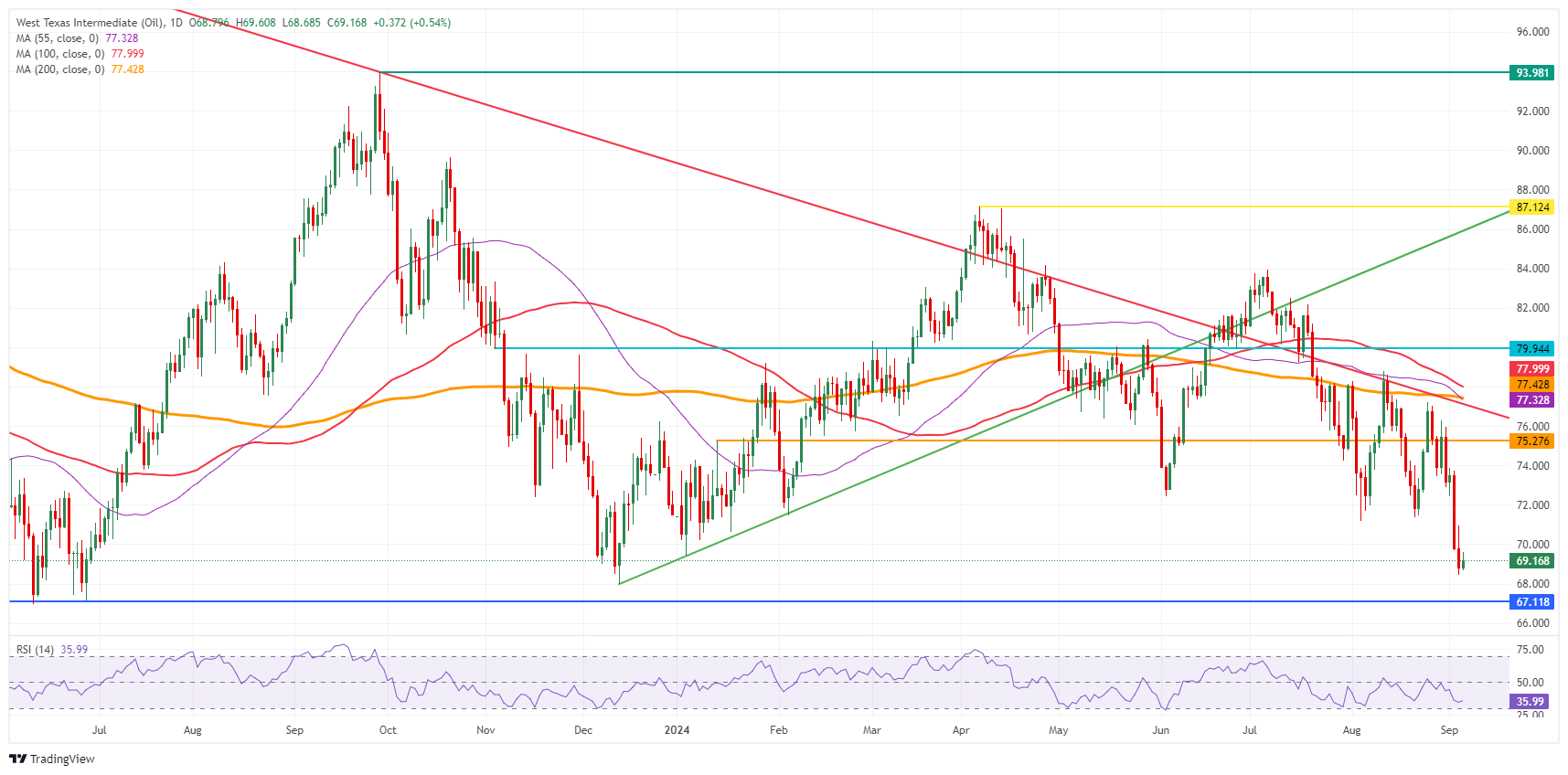- Crude oil is flat near Wednesday’s low.
- OPEC is close to reaching an agreement to delay its production increase in order to support oil prices.
- The US Dollar Index is trading just above 101.00 amid renewed downward pressure.
Crude oil sees OPEC headline impact fade as markets brace for more US data. The oil cartel’s initial plan was to boost output by an additional 180,000 barrels per day in October, but the recent falling demand outlook could put prices on a further downward trajectory if OPEC opens the floodgates too soon and too fast.
The US Dollar Index (DXY), which tracks the performance of the US Dollar against a basket of currencies, is falling towards 101.00 after Wednesday’s US JOLTS job openings data suggested that labor market conditions are easing rapidly. Not only were the previous month’s figures revised downwards, but also the actual number for July was well below 8 million. Against this backdrop, markets are starting to price in further rate cuts by the US Federal Reserve (Fed), which is weighing on the US Dollar.
On Thursday, traders will look to the ADP employment report and weekly jobless claims for further clues on the state of the US labor market.
At the time of writing, WTI crude oil is trading at $68.96 and Brent Crude at $72.95
Oil and Markets News: OPEC Caught in the Middle Again
- Bloomberg reports Thursday that OPEC+ is close to a deal to postpone oil supply increases, according to several delegates.
- The Bloomberg Commodity Index could continue to fall as U.S. recession fears re-emerge, potentially leading to further declines for crude oil prices, Bloomberg reports.
- Reuters reports that Malaysia’s national oil company Petroliam Nasional Bhd. (Petronas) has posted a 19% drop in first-half net income due to higher taxes and a reduction in its asset base.
- The Energy Information Administration (EIA) will report on Thursday the change in U.S. crude oil inventories for the week ending Aug. 30. The previous number was a decrease of 846,000 barrels, with an expected decrease of 900,000 barrels.
- The American Petroleum Institute (API) change in U.S. crude oil inventories showed a sharp decline of 7.8 million barrels, more than double the 3.4 million barrel draw the previous week and the 900,000 barrel draw expected by markets.
Oil Technical Analysis: Keep Calm
Crude oil price action is likely to be very challenging. From a purely technical standpoint, crude oil prices could dip a bit further before finally finding vital support to bounce off. This thesis is confirmed by the Relative Strength Index (RSI) momentum indicator, which has not touched or tested the oversold region, giving a false impression that the bounce has already started. Still, fundamental factors matter more here and the devil will be in the details of the OPEC postponement. This delay seems to be the minimum needed to keep crude oil prices afloat at current levels.
On the upside, the lost $75.27 will be the first level to retrace. Next, the double level at $77.43 aligns with a downtrend line and the 200-day Simple Moving Average (SMA). In case the bulls can break above it, the 100-day SMA at $78.00 could trigger a rejection.
On the downside, the August 5 low at $71.17 has been broken. From here, the big figure of $68.00 is the first level to watch, followed by $67.11, which is the lowest point of the triple bottom seen in June 2023.
WTI Crude Oil Daily Chart
WTI Oil FAQs
WTI crude oil is a type of crude oil sold on international markets. WTI stands for West Texas Intermediate, one of three main types that include Brent and Dubai crude. WTI is also known as “light” and “sweet” for its relatively low gravity and sulfur content, respectively. It is considered a high-quality oil that is easily refined. It is sourced in the United States and distributed through the Cushing hub, considered “the pipeline crossroads of the world.” It is a benchmark for the oil market and the price of WTI is frequently quoted in the media.
Like all assets, supply and demand are the main factors determining the price of WTI crude oil. As such, global growth can be a driver of increased demand and vice versa in the case of weak global growth. Political instability, wars and sanctions can disrupt supply and impact prices. Decisions by OPEC, a group of large oil producing countries, are another key driver of price. The value of the US Dollar influences the price of WTI crude oil, as oil is primarily traded in US Dollars, so a weaker Dollar can make oil more affordable and vice versa.
The weekly oil inventory reports published by the American Petroleum Institute (API) and the Energy Information Agency (EIA) influence the price of WTI oil. Changes in inventories reflect fluctuations in supply and demand. If the data show a decrease in inventories, it may indicate an increase in demand, which would push up the price of oil. An increase in inventories may reflect an increase in supply, which pushes down prices. The API report is published every Tuesday, and the EIA report the following day. Their results are usually similar, with a difference of 1% between them 75% of the time. The EIA data is considered more reliable because it is a government agency.
OPEC (Organization of the Petroleum Exporting Countries) is a group of 13 oil-producing nations that collectively decide on member countries’ production quotas at biennial meetings. Their decisions often influence WTI oil prices. When OPEC decides to reduce quotas, it can restrict supply and drive up oil prices. When OPEC increases production, the opposite effect occurs. OPEC+ is an expanded group that includes ten other non-OPEC countries, most notably Russia.
Source: Fx Street
I am Joshua Winder, a senior-level journalist and editor at World Stock Market. I specialize in covering news related to the stock market and economic trends. With more than 8 years of experience in this field, I have become an expert in financial reporting.








